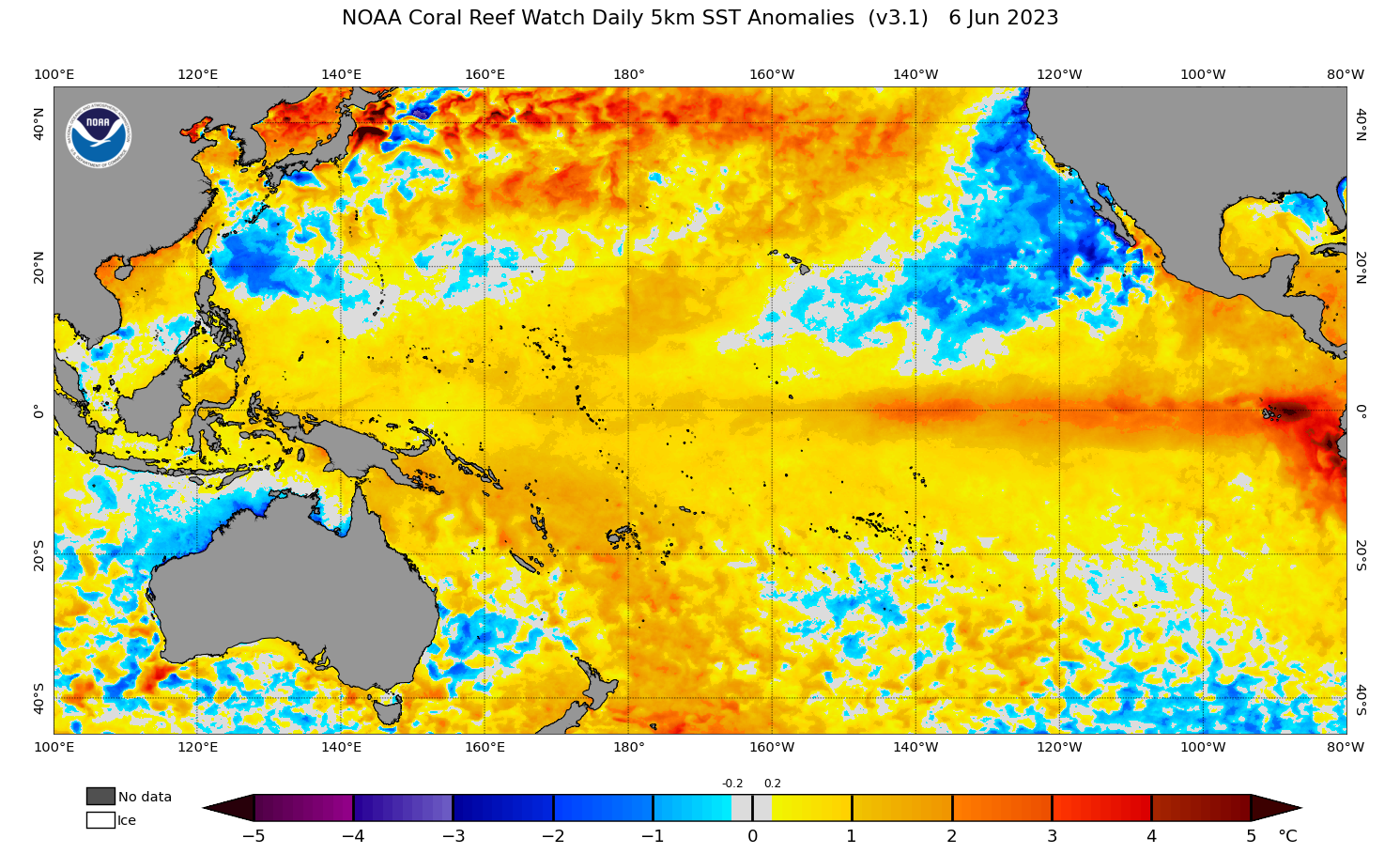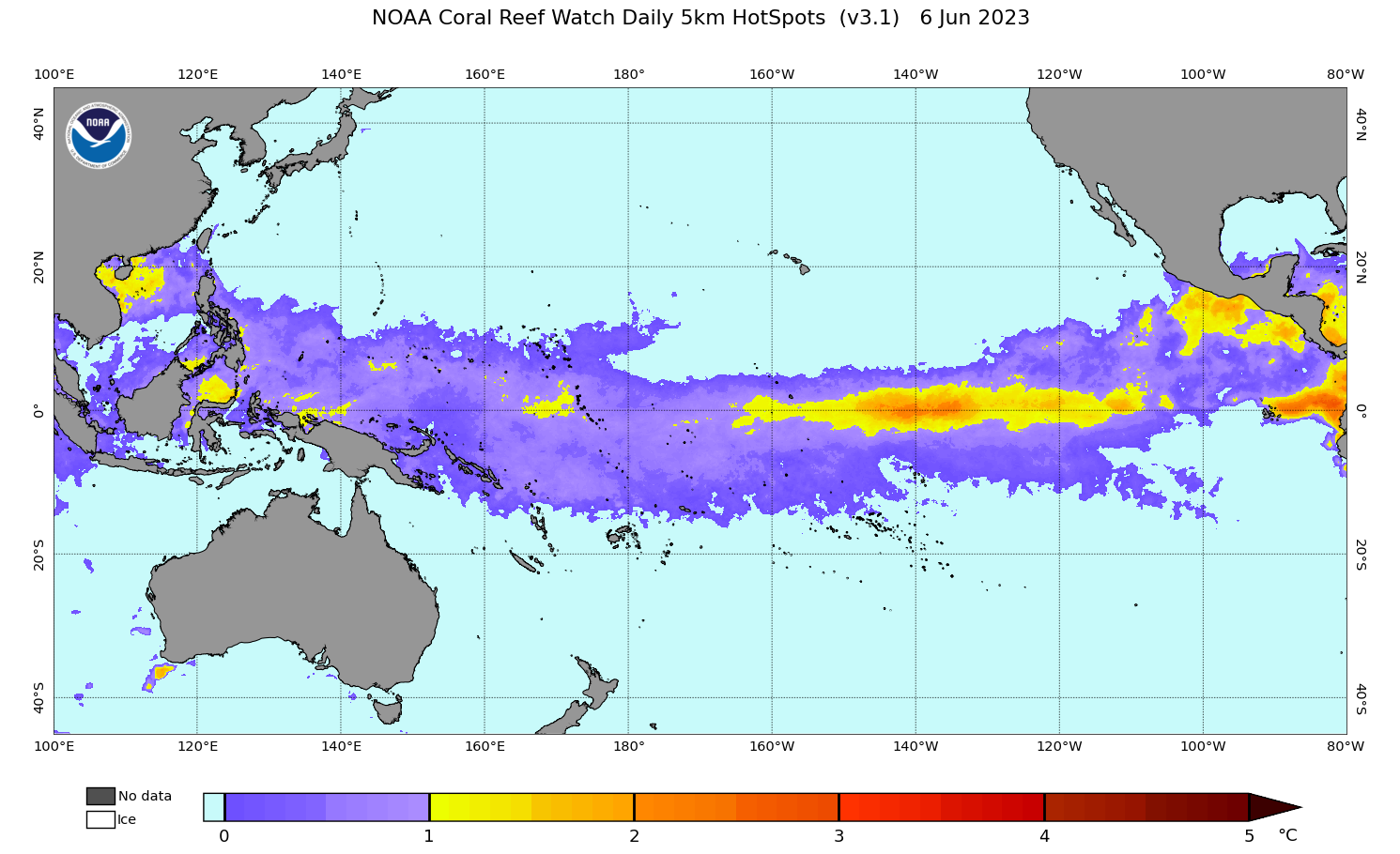Coral Bleaching Heat Stress Analysis and
Seasonal Guidance through September 2023
(Released June 7, 2023)
Current conditions:
NOAA Coral Reef Watch's (CRW) near real-time satellite monitoring shows that as of June 6, 2023, above-average sea surface temperatures (SSTs) continue to increase across the eastern equatorial Pacific Ocean, with the strongest positive anomalies (as much as 5°C above normal) around the Galapagos Islands and the coast of Peru (Figure 1). Since early 2023, positive SST anomalies have dominated the equatorial Pacific, with above-average SSTs persisting in areas of the southern Pacific, including Papua New Guinea (PNG), the Solomon Islands, Vanuatu, New Caledonia, Fiji, and the Austral Islands. A swath of below-average SSTs remains in the eastern North Pacific, however, stretching east from the Main Hawaiian Islands. In the western North Pacific, the large area of significantly below-average SSTs in the Philippine Sea, present since late May, helped influence Super Typhoon Mawar (one of the strongest storms ever observed worldwide in the month of May), which battered Guam on May 24. As of May 11, 2023, the NOAA National Centers for Environmental Prediction's (NCEP) ENSO Alert System status is: El Niño Watch. A transition from ENSO-neutral to El Niño conditions is expected in the next couple of months, and there is a greater than 90% chance the El Niño will persist into Northern Hemisphere winter.

|
||
|
Figure 1. NOAA Coral Reef Watch's Satellite Sea Surface Temperature (SST) Anomaly product for the Pacific region. |
||
Over the past three months, Coral Bleaching HotSpots >1°C have diminished in the southern hemisphere and have concentrated in the central and eastern equatorial Pacific (Figure 2). Since late April/early May, NOAA CRW's daily 5km satellite Regional Virtual Stations for Eastern New Caledonia, Vanuatu, and Fiji have returned to Bleaching Watch or No Stress, after multiple months of Alert Levels 1 and 2 heat stress (Figure 3). At the same time, the Galapagos, Ecuador and Costa Rica Pacific stations have elevated to Alert Level 2. Coral bleaching was reported in both Costa Rica and El Salvador (currently at Bleaching Warning).
***CRW would be very grateful if local stakeholders would continue to share their in-water data and observations of coral bleaching/no bleaching in these regions, to clarify what has been and is being observed on their reefs. Users can contribute their data to NOAA CRW via email (to coralreefwatch@noaa.gov), a Google Form, and/or via a more detailed, quantitative observations questionnaire. (Please see https://coralreefwatch.noaa.gov/satellite/research/coral_bleaching_report.php for more information.)***

|
||
|
Figure 2. NOAA Coral Reef Watch's Satellite Coral Bleaching HotSpot product for the Pacific region. |
||

|
||
|
Figure 3. NOAA Coral Reef Watch's Satellite Bleaching Alert Area (7-day maximum) product for the Pacific region. |
||
CRW's most recent, modeled Four-Month Coral Bleaching Outlook (Figure 4) projects heat stress will remain in the eastern equatorial Pacific during Northern Hemisphere summer. Additionally, Alert Level 1 heat stress is predicted to reach Nauru and the Gilbert Islands, Kiribati by July 2023. CRW is continuing to monitor a large swath of heat stress to the north of the Northwestern Hawaiian Islands, which may lead to Alert Level 1 conditions for the region by September 2023.

|
||
|
Figure 4. NOAA Coral Reef Watch's Four-Month Coral Bleaching Outlook of June 6, 2023, for June-September 2023, for the Pacific region. |
||
***CRW recommends regular review of its Four-Month Coral Bleaching Outlook maps (https://coralreefwatch.noaa.gov/satellite/bleachingoutlook_cfs/index.php) and near real-time satellite product updates (https://coralreefwatch.noaa.gov/product/5km/index.php), for all regions of interest/concern, over the months ahead.***
CRW's current satellite and modeled products can be found at:
https://coralreefwatch.noaa.gov/index.php
CRW's modeled Four-Month Coral Bleaching Heat Stress Outlooks can be found at:
https://coralreefwatch.noaa.gov/satellite/bleachingoutlook_cfs/outlook_cfs.php
CRW's 5km satellite Regional Virtual Stations can be found at:
https://coralreefwatch.noaa.gov/product/vs/map.php
Sign up for automated bleaching alert emails for CRW's 5km Regional Virtual Stations at:
https://coralreefwatch.noaa.gov/subscriptions/vs.php
Please report bleaching events (or non-events) at:
https://coralreefwatch.noaa.gov/satellite/research/coral_bleaching_report.php
Disclaimer
The content posted on this web page solely represents the opinions of the authors and does not constitute a statement of policy, decision, or position on behalf of NOAA or the US Government.
The appearance of external links on this World Wide Web site does not constitute endorsement by the Department of Commerce/National Oceanic and Atmospheric Administration of external Web sites or the information, products or services contained therein. For other than authorized activities, the Department of Commerce/NOAA does not exercise any editorial control over the information you may find at these locations. These links are provided consistent with the stated purpose of this Department of Commerce/NOAA Web site.